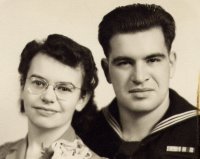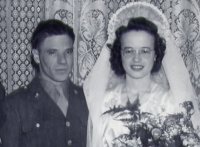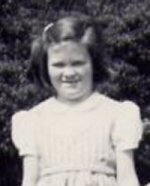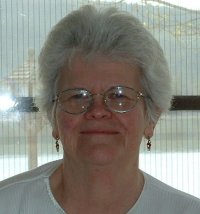| Joann was serven when Pearl Harbor was attacked, but can recall that even though she was at home with her parents in Spokane when the war started, she didn't fully comprehend the significance of the attack until much later when she studied history in school. |
| Joann however recalls vivid memories of collecting scrap metal for the war effort with her little red wagon: One of the first memories I have was that I had a red wagon and we collected scrap from the vacant lots. See we had lots and lots of vacant lots in our area you know we had some older homes and oh every once in awhile there'd be a house built but mainly not until after the war was over was a bunch of houses built. So the collection area then was the elementary school and because my mother and dad didn't have a car I think we kids pooled the stuff and took it over to the school 'cause we walked to the school with it all. |
| WHAT DO YOU REMEMBER OF THE RATIONING SYSTEM? |
| Well ration stamps meant limited sugar to cook with, meat and bread and butter and that's the time that margarine came to be introduced. And margarine at first came in a white blob-like my sister told me over the weekend and to get it yellow so you thought it was yellow we, there was a little packet in there of yellow concentrate and you paddled it and our job was to mix it evenly and this was a Saturday job to mix it evenly in that white blob and make it yellow. So the margarine advanced during that time to a packaged it in a ball and a button was in there and all you had to do was push the button and all you had to do was squeeze the button and you squeezed the ball and you didn't have to use paddles anymore or a spoon to do it anymore. |
| And in our house we had sugar jars for each member of the family and we got one cup of sugar each week. Now that's a heck of a lot of sugar isn't it by today's standards? Anyway that was used for our cereal and anything else we had to put sugar on. But my mother had a deal where if we would save some sugar and had sugar left in our jar and the way she did it was we each had a colored topped like a sugar pourer like you see in the restaurants, they weren't metal then, they were plastic and we each had our own colored lid because there were three girls and my mother and father, so there was five of those. So we pooled the sugar at the end of the week before we poured more sugar in it, we pooled that sugar and we could make cake, pie, cookies or something like that. My mother had a wonderful recipe for eggless and milkless and butterless cake. It was absolutely delicious and she would back that often. For canning in the summer, the sugar left at the end of the week and then you put another cup in each person's jar and that sugar that was in reserve would be used for canning, so you know it was real frugal, my mother did a nice job of that. |
| We had Buster Brown shoes and penny loafers and shoes there was only enough stamps for a pair of shoes at the beginning of school and those had to last you until Easter, then you got a pair of Easter shoes and they had to last 'til school in the Fall. They were resoled and repaired. Saddle shoes were one of our favorites and of course the penny loafers when we got older. |
| A CHILDREN'S MEMORIES OF THE WAR |
| We went to the movies on Saturday and along with that movie was the newsreel and so we watched the newsreel which had some selective pictures of what was going on in the war and there were action pictures of what was going on in the war and it was really scary when you thought about it too much, so I didn't think about it too terribly much. |
| My best friends mother, she lived over two houses from us was our block captain in case, she was the Air Raid Block Captain, and she would run us through drill once in awhile, and that meant it was it was in the evening she would do it to make sure we had our dark shades pulled over our windows. we did this because of our close proximity to the coast. Because they were afraid the Japanese were going to attack the West Coast. Anyway we had dark shades over the windows. |
| THE 4th AVENUE USO |
| Joann had older sisters, both of which were out of high school by 1944 when they started bringing soldiers and sailors over to their home, something that for a 10 year old was very exciting: |
| Well see it was very interesting for me because my sisters were older and they had boyfriends which were in the service and so there were a lot of servicemen that came and went, but they'd fill up our dining room table every holiday, and I loved it because I was ten and I was kind of in awe, because I didn't have any brothers, of all that, and I remember it was so significant to me because I can remember making a sign that said, "4th Avenue USO," and putting it on our front door. [laugh] my sisters married during the war and my older sister Iona married Don and he was in the Navy on the USS Boise. My middle sister, what I call my middle sister, and this is Thelma, she married Jack who was in the Army, he served in England, France and I believe Italy. He was a welder, he repaired planes. |
  |
Iona and Don and Thelma and Jack
Joann's sisters and their husbands |
| WHAT WERE YOUR IMPRESSIONS OF THE WAR AS A KID? |
| My perception was not one of fear, it was one of, "Oh this is fun, we get to do this because this is important." |





